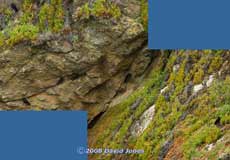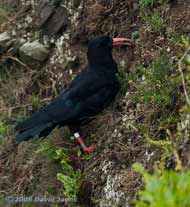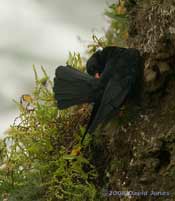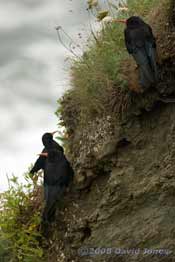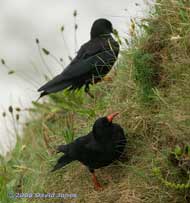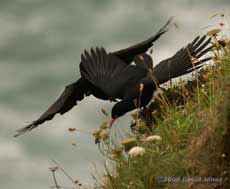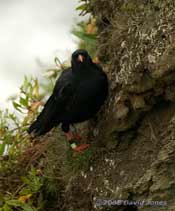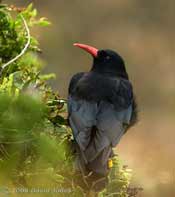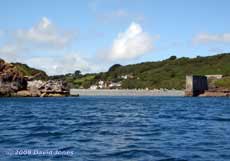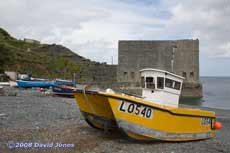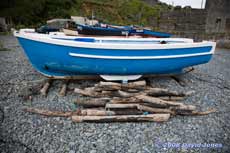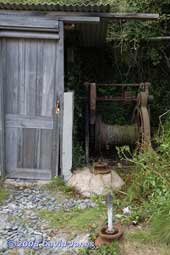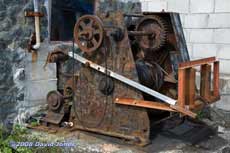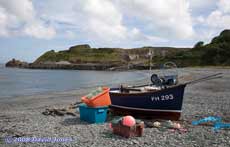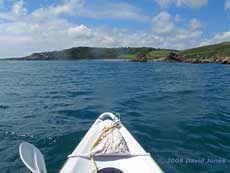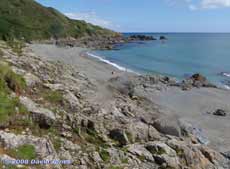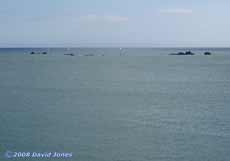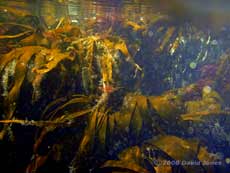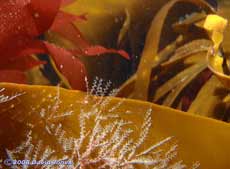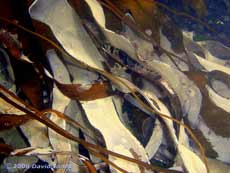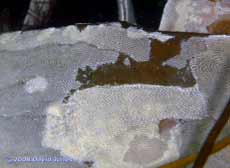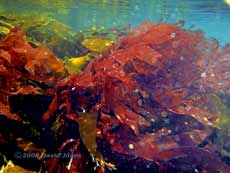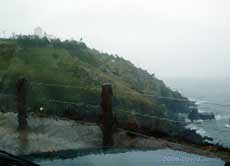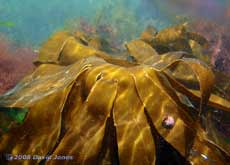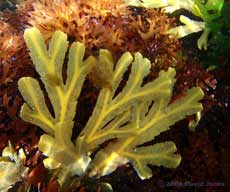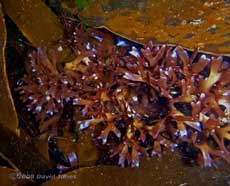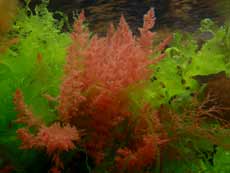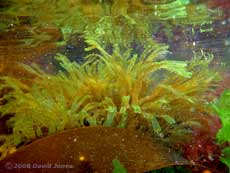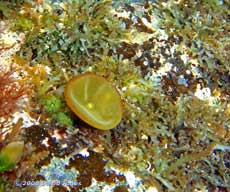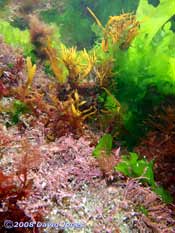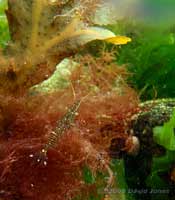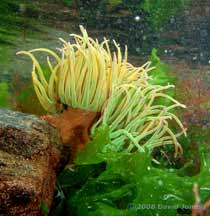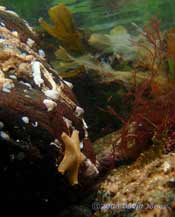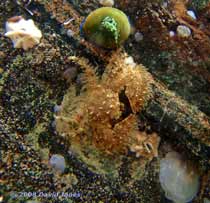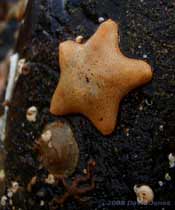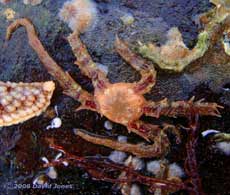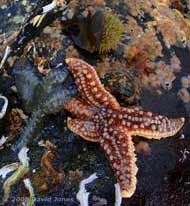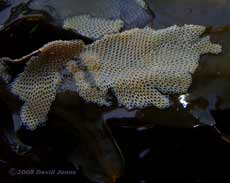Go to the last entry on this page .....Go to previous entry1 August - The damp weather continues, although there was a sunny period around the middle of the day (which I missed - sleeping!). We headed out in the afternoon, and after a picnic at the top of the cliff above Poldhu Cove (no pics) it was back to Lizard Point again. Unlike yesterday, there was no blue sky in the evening, but there was a real treat. The sighting of a single Chough flying over the car park had me scouring the cliffs above Polpeor Cove, and it didn't take long to spot not one but six Choughs (could it be the complete family?) on a leeward section of cliff. At that time it was still quite wet and I had to keep the camera covered, so I didn't take any more photographs of them in this position.
However, a short while later the rain stopped and the whole family flew over us and headed around the headland past the lighthouse. Then , just when I thought we had seen the last of them, they appeared once again. This time there were seven of them, flying as a group, with some playful interactions between them before they all landed on the cliff above Polbream Cove, some just below the bench featured in one of yesterday's photographs. The overcast conditions meant that light levels weren't great, but it was an opportunity not to be missed, and I took lots of photographs, although I'll include only some here.
They were engrossed in the search for food and I watched as they used their long beaks to hack into the soil,
stopping only occasionally to preen.
Although there were up to six Choughs feeding, the uneven edge meant that for most of the time only one or two, or occasionally three were visible.
While they seemed to be happy to share a spot with another member of the family,
occasionally it seemed that there was always the urge to compete with a sibling over a good spot!
I hope that I've taken pictures of all the Chough group, including their leg rings. When I have time (and the information I need about the colours used this Spring) I will go through all the pictures to see if I actually collected a 'full set'.
Several times the Choughs came so close to the cliff top that they were too close and I had to be careful not to disturb them. This picture was the closest that I risked, although this wasn't taken using my tripod.
It was a real treat, being able to watch the Choughs at such close range for such a long time. It was so good to see the family together like this, having missed the fledging in June.
Like Porthallow, the beach is a flat area of gravel with a steep slope down to the sea, and was probably created in the same way - with quarry waste. Either side of the cove are concrete structures related to the quarrying. Porthoustock is much more of a working cove than Porthallow. The right side of the cove (as seen from the sea) is occupied by a number of small fishing boats. The building behind the yellow boat once housed chutes that fed quarry stone into ships.
To launch the boats, the fishermen use greased rollers (wood, or plastic tubes) to ease the passage of the boat down over the gravel of the slope. The smaller boats will be pushed by hand, although a tractor is at hand for the larger ones.
To haul the boats back up the beach a winch is used. While Porthallow has just one, I counted ten winches here, all looking as though they are still used. Housed in small buildings, they all look as though they have been in place for a very long time. In some cases the whole contraption is hidden inside, but in some cases, like this one the engine is housed inside while the simple winch itself is outside, linked to the engine by a drive shaft. Strategically placed pulleys are used to guide the cable.
This winch, with a chain drive to link it to the engine, dwarfed the others, and looks as though more than a little bodging has gone into its construction!
Looking back across the cove you can see that the quarry is in use. It is an old quarry that was reopened some years ago. Near the end of the headland you can see piles of gravel being prepared for the arrival of a ship.
After the winds of the last week I was surprised to see how calm the water was and decided to get out on the kayak and explore a 'new to me' part of the coastline.
You can see it directly in front of the kayak. To the left of the picture you can also see some of the machinery at another working quarry at Dean Point. This is a much larger quarry, producing gravel for roads etc, most of which is taken out by ship.
I actually landed in Leggan Cove, just short of Godrevy itself. although only separated from Godrevy by a large rock. I've got to remember to check the lens for water droplets!
Looking out for the beach you can see the Manacles, a rocky outcrop that is a magnet for scuba divers, although there didn't seem to be any about this afternoon, even though the sea was almost flat calm.
After a rest I started back, and during the journey I had another pause in shallow water close inshore. Drifting amongst thick beds of Laminaria seaweed, I dipped the camera to try out a few different settings.
In that first picture you can see white, feathery growths on the Laminaria fronds. In this second picture you can see the 'zig-zag' appearance of these fronds, which are actually colonial polyps belonging to the class of animals known as hydroids. I noticed that some have a distinctly pink colour - hopefully I can get to photograph these at another time.
In other places, the Laminaria fronds are covered with a white coating. This is also due to an animal, this time a marine bryozoan called a Sea Mat (Membranipora membranacea).
The bryozoans form a lace-like covering which you can see more clearly in this second picture.
And a final picture of a red seaweed that was mixed in with the Laminaria - I cannot sort out what species it is using my seashore guide. I need to see a plant in isolation.
After that it was a case of heading back into Porthoustock and putting on the kettle! Over the next two days there are Spring Tides with low water around the middle of the day. Weather permitting I hope to do some more rock pool dipping with the camera.
3 August - A bit of a wash-out! Wet all day until now at around 7.30pm when I can see blue skies over the caravan!
This was the watery view towards the Lizard lighthouse from our vehicle after we had called into the Polpeor café for a meal. The rain may have been really miserable, but the sea was certainly a lot calmer today.
Not surprisingly, there was no sign of either Choughs or Kestrels. Even the gulls were conspicuous by their absence! The only two Jackdaws we saw looked as though they had just fallen out of a washing machine mid-cycle as they searched for non-existent scraps amongst the deserted tables outside the café. The forecast for tomorrow looks better, at least until the late afternoon when rain is due to arrive again. Once it starts, it may well stay wet for the following two days - ugh!
4 August - Blue skies greeted us when we first looked out this morning and just about stayed with us all day, although with a cool northerly breeze. Annoyingly, while the sea was calm down in Porthallow Cove, I couldn't drum up enough energy to get out on the kayak. However, I wasn't going to completely waste a Spring low tide in the early afternoon I headed for the water's edge with the Olympus. Porthallow has very little in the way of rock pools but to the right of the cove the foreshore is made up of small rocks right down past the low water mark and they provide shelter for a wide variety of plant and animal life. I spent time wading at the edge of the sea, recording just a bit of the life there.
First, another shot of Laminaria (also known as Oarweed or Tangle), this time showing how the fronds spread like fingers from a wide blade.
Another widespread brown seaweed here is Toothed, or Serrated Wrack (Fucus serratus). This is a young plant. Behind it is a red seaweed with a striking characteristic -
Many of the frond tips have a very bright blue irridescence. I'm not sure of the species, but I think it is related to Nitophyllum punctatum.
Another red seaweed, with a very feathery appearance is this one which I cannot match with anything in my seashore guide. Its colour contrasts green Sea Lettuce around it.
While the seaweeds photographed above were plentiful, the next photograph shows the only example I could find of this species. I don't recall seeing this seaweed before. The branching fronds were pale, yellowish green and delicate. It may be Dictyota dichotoma.
Discs like this appear on lots of rocks, but not in my seashore guide - am I simply looking at a young seaweed of some sort? And what is the lichen-like growth that is covering much of the stone?
I think that the brown seaweed in the centre-background of this shot is probably Knotted Wrack (Ascophyllum nodosum), and the pink plants in the foreground are likely to be Corallina officinalis.
I managed to get only a few animal photographs, this prawn posing for just a few moments before darting off into the undergrowth.
Unlike the prawn, this Snakelocks Anemone wasn't going anywhere, its exposed brown body attached to a rock.
Most animals take advantage of the shelter provided by the weed and the rocks. Turning over a stone revealed this small Cushion Star (possibly Asterina gibbosa) which wasted no time in heading back under the stone (While I replaced anyway afterwards).
On another stone was this Broad Clawed Porcelain Crab (Porcellana platycheles).
Back out of the water I had a look under a few stones. Here, another Cushion Star shares its resting place with a tiny Brittle Star.
This much larger Brittle Star has lived up to its name, with several truncated arms. The next time I find one of these I must be sure to photograph it under water to see its spines more clearly - I must take a large container the next time I go rock-pooling!
On the same rock were these two starfish, possibly Marthasterias glacialis - a great contrast between their colours, and I've never seen one as grey. And just above them another Echinoderm, possibly a small Edible Sea Urchin (Echinus esculentus)
And finally, a closer view of what is either Sea Mat or a related species of bryozoan, this time on Serrated Wrack. The individual bryozoans occupy the box-shaped 'cells' of the structure, each of these being called a zooid.
Sadly, my rock pooling came to and end when the camera battery ran out of energy! Click on images to see larger versions |
|
